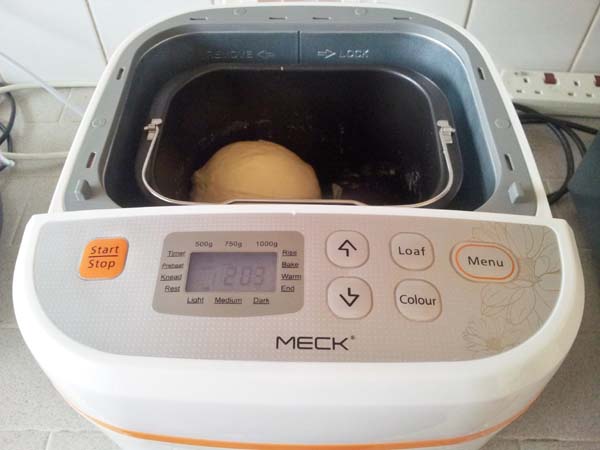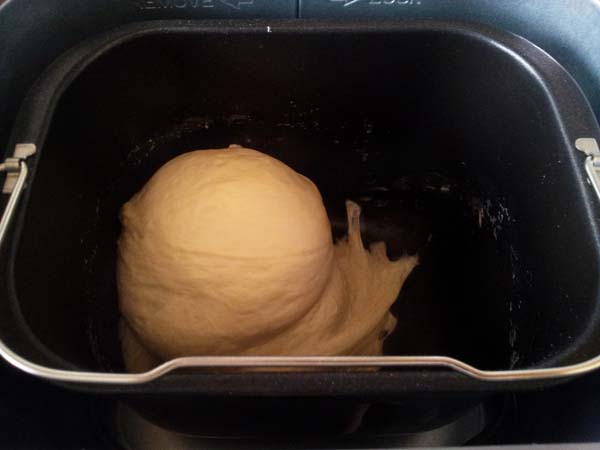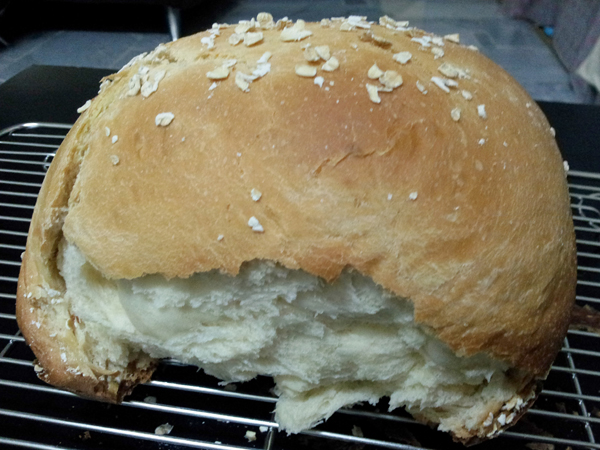Almost everyone eats bread daily, especially for breakfast (unless you do not like bread or have an allergy to gluten). Bread making is a complicated task. It requires knowledge, skill, a lot of hard work and time – kneading, resting, rising and baking; yeast (dry yeast, fresh yeast, instant yeast), bread flour (bread flour, wheat flour), weather, temperature, etc. I have failed many times in making bread. However, I have learned a lot from those failures. Should I get a Bread Maker? Yes, you should if you do not like kneading (like me). Is it worth getting a bread maker? Definitely, see below.
Meck Bread Maker MBM-2201A
| Name | Meck Bread Maker | ||
| Model | MBM-2201A | Capacity | 500g-1000g |
| Voltage | 220-240VAC | Frequency | 500W |
| Power | 50/60Hz | Motor power | 110W |
| N.W/G.W | 5.9kg/6.1kg | ||
| Dimension | 391(L) x 334(W) x 347(H) mm | ||
Specifications:
- Multiple bread types: Basic, French, Whole Wheat, Sweet, Dough, Quick, Bake, Cake, Yogurt, Jam
- Multiple working programs: Timer, reheat, knead, rest, rise, bake, warm, end
- Loaf setting: 500g, 750g, 1000g
- Color setting: Light, Medium, Dark
- Automatic kneading
- Easy operation
- 15 hours timer
- Power failure backup
- Keeping warm function
- Safety features
How to use a bread maker
- Attach the kneading blade onto the shaft inside the baking pan by lining up the flat side of the blade firmly onto the shaft.
- Add water or milk.
- If need to add eggs, should reduce equal parts of water.
- Add some salt at the corner of bread pan.
- Add some sugar at the corner of bread pan.
- Add beef tallow or butter.
- Add flours, let it cover the whole water surface.
- Use measuring spoon opens a small pit.
- Add yeast into the pit, ensure that not contact to salt and keep dry.
- Clockwise rotation the baking pan and firmly click into place.
- Close the lid.
- Choose the correct function for your recipe by pressing the buttons.
Ingredients to make bread
1. Bread flour
Bread flour is high gluten/protein flour that has been treated with conditioners to give dough a greater tolerance during kneading. Bread flour typically has a higher gluten concentration than all-purpose flour. Using bread flour with the bread machine will produce loaves with beeter volume and structure.
2. All-purpose flour
All-purpose flour is a blend of refined hard and soft wheat flours especially suitable for making breads and cakes. The most popular brands of flour have been tested for quick bread in The Bread Machine with excellent results.
3. Whole wheat flour
Whole wheat flour is milled from the entire wheat kernel, which contains the bran and germ. Whole wheat flour is heavier and richer in nutrients than all-purpose flour. Breads made with this flour are usually smaller and heavier than white loaves. Many recipes mix whole wheat flour with bread flour or gluten to produce high, light-texture bread.
4. Cake flour
Cake flour is made from softer or lower protein wheats and is specially designed for use in cake recipes.
5. Cornmeal and oatmeal
Cornmeal and oatmeal come from coarsely ground white or yellow corn and from rolled or steel-cut oats. They are used primarily to enhance the flour and texture.
6. Sugar
Sugar is important for the color and flavor of breads. It also serves as food for the yeast as it supports the fermentation process. Recipes calls for sugar require granulated sugar. Do not substitute powdered sugar unless indicated. Artificial sweeteners cannot be used as a substitute for sugar as the yeast will not react properly with them.
7. Yeast
Yeast, through a fermentation process, produces gas (carbon dioxide) necessary to make the bread rise. Yeast feeds on sugar and flour carbohydrates to produce this gas. Traditional active dry granular yeast is used in all recipes that call for yeast. Three different types of yeast are available: fresh (cake), dry, and quick acting. Bread machine yeast is quick acting. For best results, use traditional dry yeast. However, quick rising yeast can also be used in smaller amounts.
Always store yeast in a refrigerator to keep it fresh as heat will kill it. Ensure your yeast is fresh by checking its expiration date. Once a package or jar of yeast is opened, it is important that the remaining contents be immediately resealed and refrigerated for future use. Often bread or dough that fails to rise is due to stale yeast. The following test can be used to determine if your yeast is stale and inactive:
- Place ½ cup of lukewarm (40°C~45°C) water into a liquid measuring cup.
- Stir 1 teaspoon of sugar into the water and then sprinkle 2 teaspoons of yeast over the surface.
- Place cup in a warm area and allow to sit for 10 minutes undisturbed.
- The mixture should foam and rise to the 1-cup mark. If this does not occur, discard this yeast and purchase fresh yeast.
Conversion Chart for Fast-Rising Yeast
- 1 teaspoon active dry yeast = ¾ teaspoon quick-rising yeast
- 1.5 teaspoon active dry yeast = 1 teaspoon quick-rising yeast
- 2.25 teaspoon active dry yeast = 1.5 teaspoon quick-rising yeast
- 1 tablespoon active dry yeast = 2 teaspoon quick rising yeast
8. Salt
Salt is necessary to balance the flavor of breads and cakes, as well for the crust color that develops during baking. Salt also limits the growth of yeast. Do not increase amount of salt shown in the recipes. For dietary reasons, salt may be eliminated. However, the bread may overproof and rise higher than normal.
9. Eggs
Egg adds richness and a velvety texture to bread dough and cakes.
10. Fats: shortening, butter and oil
Shortening, butter and oil shorten or tenderize the texture of yeast breads. French bread gets its unique crust and texture from the lack of fat added. However, breads that call for fat stay fresh longer. If butter is used directly from the refrigerator, it should be cut into small pieces for easier blending during the kneading cycle.
11. Baking powder
Baking powder is a leavening agent used in quick breads and cakes. This type of leavening agent does not require rising time before baking as the chemical reaction works when liquid ingredients are added.
12. Baking soda
Baking soda is another leavening agent not to be confused or substituted for baking powder. It also does not require rising time before baking as the chemical reaction works during process.
13. Liquids
Liquids, such as milk (1%, 2%, whole, and skim), water, or a combination of powdered milk and water, can be used when making bread. Milk will improve flavor, provide a velvety texture and soften the crust, while water alone will produce a crispier crust. Some recipes call for juice (orange, apple, etc.) to be added as a flavor enhance.
Meck Bread Maker Review: Fully Automatic Compact Bread Maker
Meck Bread Maker is very simple and easy to use. It can realize different function, such as making a variety of “Bread”, “Fermentation”, “Kneading”, “Jam”, and “Baking” and so on. The size (40L x 33W x 35H) is ideal for my small kitchen and fits nicely on the counter without any issue. This bread maker can make a large loaf. It allows you to choose different sizes (500g, 750g, 1000g) to bake and comes with three crust setting to choose from – be it light, medium and dark. The whole process of dough to the edible bread can be watched through viewing panel. The kneading paddle and bread pan can be easily removed for cleaning purposes. I have tried to make a loaf of bread with “Basic” and light bread crust function. It took about three hours to make a loaf of bread, fully automated, all you have to do is put ingredients. I am very happy with the outcome. The bread was very moist and fluffy and best of all, a beautiful brown crust! I have also tested “Sweet” and “Cake” functions, but it was a bit disappointed. The outer layers of both “Sweet Bread” and “Cake” were a bit harder than I expected.









Where to buy Meck Bread Maker
Meck Bread Maker MBM-2201A sells at RM399.00 on Lazada, I bought it at RM349.00 with Lazada RM50 Voucher (read: Ways to save money on Lazada Malaysia). The bread maker comes with 3 accessories: measuring cup, measuring spoon and bread hook. Use the measuring tools to measure ingredients. Use the bread hook to remove the kneading blade if the blade remains in the bottom of the bread.
Bread Maker Recipes
There are 10 recipes in the booklet given together with the product, developed using traditional dry yeast.
1 cup flour = 180g
1 small spoon salt = 5g
1 large spoon sugar = 13g
1 small spoon yeast = 3g
1 cup sugar = 250g
Note: Due to different brand flour with different moisture content, please add water according to the real situation.
Basic Bread
| Ingredient | 500g | 750g | 1000g |
| Water | 190ml | 280ml | 330ml |
| Oil | 1 + 1/2 large spoons | 2 large spoons | 2 large spoons |
| Salt | 1/2 small spoon | 3/4 small spoon | 1 small spoon |
| Sugar | 1 large spoon | 1 + 1/2 large spoons | 3 large spoons |
| Milk powder | 1 large spoon | 1 large spoon | 2 large spoons |
| Bread flour | 1 + 3/4 cups (315g) | 2 + 1/2 cups (450g) | 3 + 1/9 cups (560g) |
| Yeast | 1 small spoon | 1 small spoon | 1 small spoon |
French Bread
| Ingredient | 500g | 750g | 1000g |
| Lemon juice | 1 small spoon | 1 small spoon | 1 small spoon |
| Water | 160ml | 270ml | 320ml |
| Oil | 1 large spoon | 1 + 1/2 large spoons | 2 large spoons |
| Salt | 1 small spoon | 1 small spoon | 1 small spoon |
| Sugar | 1 large spoon | 1 + 1/2 large spoons | 2 large spoons |
| Bread flour | 1 + 3/4 cups (315g) | 2 + 1/2 cups (450g) | 3 + 1/9 cups (560g) |
| Yeast | 1 small spoon | 1 small spoon | 1 small spoon |
Whole Wheat Bread
| Ingredient | 500g | 750g | 1000g |
| Water | 210ml | 280ml | 330ml |
| Oil | 1 + 1/2 large spoons | 2 large spoons | 3 large spoons |
| Salt | 1 small spoon | 1 small spoons | 1 small spoon |
| Sugar | 3 large spoons | 3 large spoons | 3 large spoons |
| Milk powder | 2 large spoons | 2 + 1/2 large spoons | 3 large spoons |
| Bread flour | 1 + 3/5 cups (290g) | 1 + 7/8 cups (340g) | 2 + 1/3 cups (420g) |
| Whole wheat flour | 1/2 cups (70g) | 3/4 cups (105g) | 1 cups (140g) |
| Yeast | 1 small spoon | 1 small spoon | 1 small spoon |
Sweet Bread
| Ingredient | 500g | 750g | 1000g |
| Water | 160ml | 220ml | 320ml |
| Oil | 1 large spoon | 1 large spoon | 2 large spoons |
| Salt | 1 + 1/2 spoon | 1 large spoon | 1 + 1/2 small spoons |
| Sugar | 1/4 cup | 1/3 cup | 1/2 cup |
| Milk powder | 1 large spoon | 1 + 1/2 large spoons | 2 large spoons |
| Bread flour | 1 + 3/4 cups (315g) | 2 + 1/2 cups (450g) | 3 + 1/9 cups (560g) |
| Yeast | 1 small spoon | 1 small spoon | 1 small spoon |
Dough
| Ingredient | |
| Water | 280ml |
| Bread flour | 2 + 2/5 cups (430g) |
Quick Bread
| Ingredient | |
| Water + Egg (1 pcs) | 280ml |
| Oil | 3 large spoons |
| Salt | 1 small spoon |
| Sugar | 1/4 cup (60g) |
| Milk powder | 2 large spoons |
| Bread flour | 1 + 2/3 cups (480g) |
| Yeast | 3 small spoons |
Cake
| Ingredient | |
| Egg | 2 pcs |
| Oil | 100g |
| Sugar | 80g |
| Cake flour | 100g |
| Baking powder | 1 small spoon |
Yogurt
| Ingredient | |
| Low temperature and original acidophilus milk | 100ml |
| Fresh pure milk | 1000ml |
1. Put low temperature and original acidophilus milk in the room for 2 to 3 hours in normal temperature to make the lactobacillus resume to be activated. Noted: Please select the original acidophilus with low temperature and activated, but not the acid milk beverage.
2. Fresh pure milk 1000ml, and boiling 5 minutes. Put some sugar inside together if make the sugar yogurt, the hot pure milk after boiling, use water to cool it with about 40 degree, or let it cool natural.
3. Remove the kneading blade, put hot water in bread pan to wash and sterilize.
4. Put the acidophilus milk in warm milk together, and blend it evenly, then put it in the knead pan and close the cover.
5. Select the “Yogurt” program, adjust the making time and start to make. Summer 4 to 5 hours, winter 6 to 8 hours.
Jam
Such as: Orange, Apricot, Peach, Pear
| Cut fruit into 1.3 m³ pieces | 2 cups |
| Sugar | 1 cup |
| Lemon juice | 2 large spoons |
Approved by:
Suruhanjaya Tenaga
Approval number: 1155/14
Distributed by:
Meck Marketing Sdn Bhd (323062-H)
Wisma Thunderflash,
No. 8, Jalan Mutiara 6,
Taman Perindustrian Plentong,
81750 Johor Bahru, Johor.
Tel: 012-787 5337
Fax: 07-353 6477
 Contact
Contact